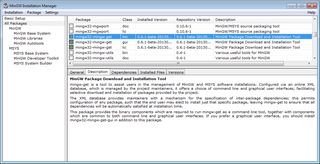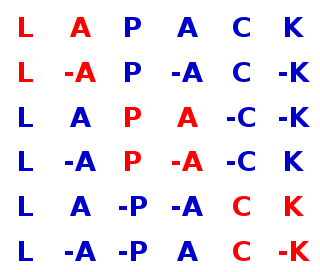Related Research Articles

Fortran is a third generation, compiled, imperative programming language that is especially suited to numeric computation and scientific computing.

MATLAB is a proprietary multi-paradigm programming language and numeric computing environment developed by MathWorks. MATLAB allows matrix manipulations, plotting of functions and data, implementation of algorithms, creation of user interfaces, and interfacing with programs written in other languages.

Wine is a free and open-source compatibility layer to allow application software and computer games developed for Microsoft Windows to run on Unix-like operating systems. Developers can compile Windows applications against WineLib to help port them to Unix-like systems. Wine is predominantly written using black-box testing reverse-engineering, to avoid copyright issues. No code emulation or virtualization occurs. Wine is primarily developed for Linux and macOS.

Maple is a symbolic and numeric computing environment as well as a multi-paradigm programming language. It covers several areas of technical computing, such as symbolic mathematics, numerical analysis, data processing, visualization, and others. A toolbox, MapleSim, adds functionality for multidomain physical modeling and code generation.

Scilab is a free and open-source, cross-platform numerical computational package and a high-level, numerically oriented programming language. It can be used for signal processing, statistical analysis, image enhancement, fluid dynamics simulations, numerical optimization, and modeling, simulation of explicit and implicit dynamical systems and symbolic manipulations.

MinGW, formerly mingw32, is a free and open source software development environment to create Microsoft Windows applications.
IDL, short for Interactive Data Language, is a programming language used for data analysis. It is popular in particular areas of science, such as astronomy, atmospheric physics and medical imaging. IDL shares a common syntax with PV-Wave and originated from the same codebase, though the languages have subsequently diverged in detail. There are also free or costless implementations, such as GNU Data Language (GDL) and Fawlty Language (FL).
Coarray Fortran (CAF), formerly known as F--, started as an extension of Fortran 95/2003 for parallel processing created by Robert Numrich and John Reid in the 1990s. The Fortran 2008 standard now includes coarrays, as decided at the May 2005 meeting of the ISO Fortran Committee; the syntax in the Fortran 2008 standard is slightly different from the original CAF proposal.

LAPACK is a standard software library for numerical linear algebra. It provides routines for solving systems of linear equations and linear least squares, eigenvalue problems, and singular value decomposition. It also includes routines to implement the associated matrix factorizations such as LU, QR, Cholesky and Schur decomposition. LAPACK was originally written in FORTRAN 77, but moved to Fortran 90 in version 3.2 (2008). The routines handle both real and complex matrices in both single and double precision. LAPACK relies on an underlying BLAS implementation to provide efficient and portable computational building blocks for its routines.
The GNU Scientific Library is a software library for numerical computations in applied mathematics and science. The GSL is written in C; wrappers are available for other programming languages. The GSL is part of the GNU Project and is distributed under the GNU General Public License.

SageMath is a computer algebra system (CAS) with features covering many aspects of mathematics, including algebra, combinatorics, graph theory, group theory, differentiable manifolds, numerical analysis, number theory, calculus and statistics.
The NAG Numerical Library is a software product developed and sold by The Numerical Algorithms Group Ltd. It is a software library of numerical analysis routines, containing more than 1,900 mathematical and statistical algorithms. Areas covered by the library include linear algebra, optimization, quadrature, the solution of ordinary and partial differential equations, regression analysis, and time series analysis.
Turnpike was a British-developed email and news client for Microsoft Windows, with an associated program for handling the Internet connection. The software, originally written by Chris Hall and Richard Clayton, first appeared in 1995. It was acquired by Demon Internet later the same year and for a number of years was supplied to their customers free of charge. In 1998, Demon Internet had over 180,000 subscribers. It is not known how many of these subscribers used Turnpike, but it must have been a substantial number. It also had a small following of non-Demon users.
NetCDF is a set of software libraries and self-describing, machine-independent data formats that support the creation, access, and sharing of array-oriented scientific data. The project homepage is hosted by the Unidata program at the University Corporation for Atmospheric Research (UCAR). They are also the chief source of netCDF software, standards development, updates, etc. The format is an open standard. NetCDF Classic and 64-bit Offset Format are an international standard of the Open Geospatial Consortium.

PsychoPy is an open source software package written in the Python programming language primarily for use in neuroscience and experimental psychology research. Developed initially as a Python library and then as an application with a graphical interface, it now also supports JavaScript outputs to run studies online and on mobile devices. Unlike most packages, it provides users with a choice of interface - they can generate experiments by writing Python scripts, use a graphical interface that will generate a script for them, or combine both methods. Its platform independence is achieved through use of the wxPython widget library for the application and OpenGL for graphics calls. It is also capable of generating and delivering auditory stimuli.

Speakeasy was a numerical computing interactive environment also featuring an interpreted programming language. It was initially developed for internal use at the Physics Division of Argonne National Laboratory by the theoretical physicist Stanley Cohen. He eventually founded Speakeasy Computing Corporation to make the program available commercially.
Mingw-w64 is a free and open-source suite of developments tools that generate Portable Executable (PE) binaries for Microsoft Windows. It was forked in 2005–2010 from MinGW.
Absoft Fortran Compilers are set of Fortran compilers for Microsoft Windows, Apple Macintosh, and Linux produced by Absoft Corporation. The compilers are source code compatible across platforms.
References
- ↑ Burguillo, F.J.; Holgado, M.; Bardsley, W.G. (2003). "Using the SIMFIT Statistical Package to teach Data Analysis in Experimental Sciences". Revista de Educacíon en Ciencias-Journal of Science Education. 4: 8–14.
- ↑ "WineHQ - Simfit". appdb.winehq.org. Retrieved 2021-10-04.
- ↑ Chivers, Ian D.; Jane Sleightholme (August 2007). "Introduction to NAG Fortran builder". ACM SIGPLAN Fortran Forum. 26 (2): 12–24. doi:10.1145/1279941.1279943. S2CID 7955473.